The Best Fabrics for Custom Baby Clothes: What Designers Use
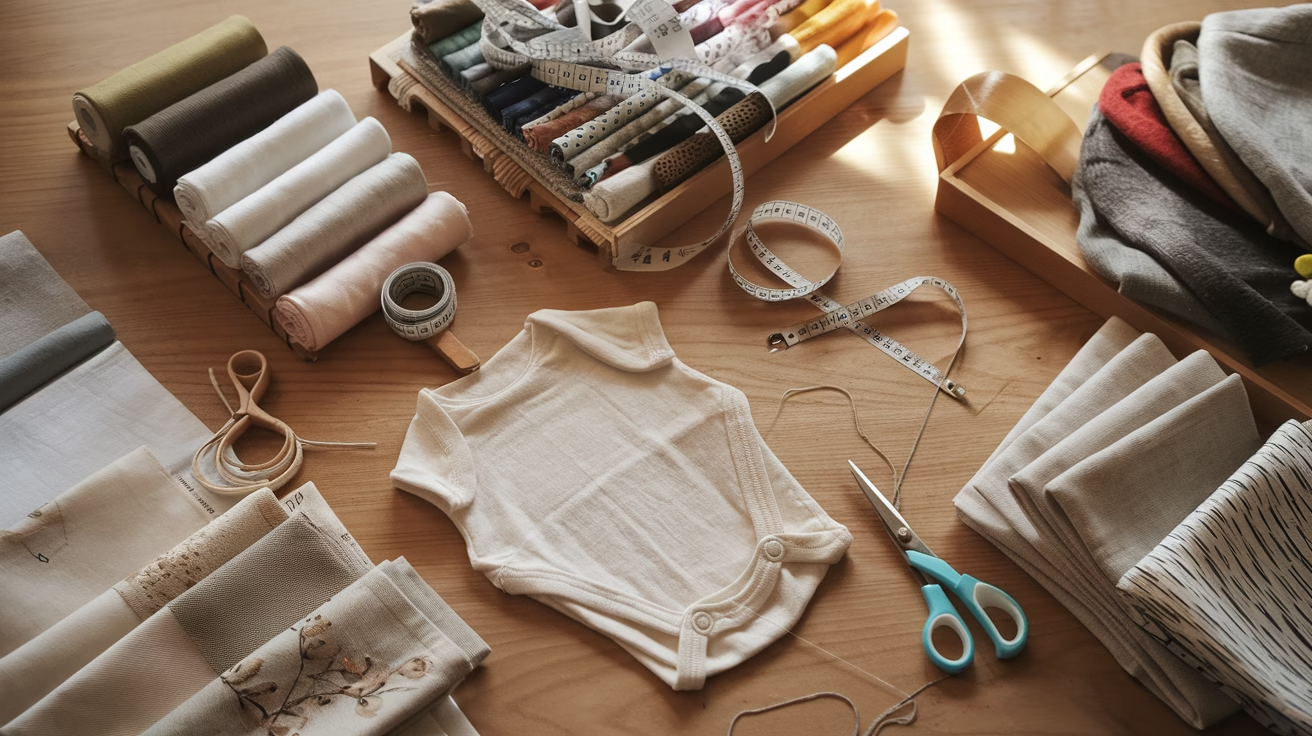
Ever stood in a baby boutique, overwhelmed by the countless fabric options, wondering what actually matters when it comes to dressing your little one? As any new parent discovers, baby skin isn’t just adorably soft—it’s incredibly sensitive, making fabric selection perhaps the most crucial decision when purchasing or designing custom baby clothes. While that adorable print might catch your eye, professional designers know it’s what touches baby’s skin that truly counts.
In today’s market, the difference between premium baby wear and mass-produced options often comes down to fabric quality. Professional designers consistently choose materials like organic cotton, bamboo, and merino wool for good reason—these fabrics offer the perfect balance of ✨ softness, breathability, and durability ✨ that babies need. With concerns about chemical exposure and environmental impact growing among parents, understanding what the experts use can help you make informed choices for your baby’s wardrobe.
In this comprehensive guide, we’ll explore the fabric selections professional designers swear by, from luxurious natural fibers to practical synthetic blends. You’ll discover how seasonal considerations affect fabric choices, learn the proper care techniques to extend the life of premium baby clothes, and gain insider knowledge about why certain materials are worth the investment when it comes to your baby’s comfort and health.

Understanding the Importance of Fabric Selection for Baby Clothes
Safety considerations: avoiding harmful chemicals and choking hazards
When designing custom baby clothes, safety must be the top priority. Many fabrics undergo chemical treatments including dyes and flame retardants that can be harmful to a baby’s sensitive skin. Parents and designers should look for certifications like OEKO-TEX Standard 100, which indicates the absence of harmful substances in the fabric. Additionally, all design elements should be carefully evaluated to eliminate small parts that could become choking hazards.
Chemical-free fabrics are especially important for infants, whose skin absorbs substances more readily than adult skin. Before putting new clothes on your baby, washing them thoroughly helps remove residual chemicals from the manufacturing process. Fast fashion brands often compromise on quality control due to rapid production cycles, potentially exposing babies to harmful substances.
Comfort factors: softness, breathability, and skin sensitivity
A baby’s skin is significantly more sensitive than an adult’s, making softness and breathability critical factors in fabric selection. Breathable materials like muslin and cotton help regulate body temperature, preventing overheating and reducing the risk of skin irritation. Hypoallergenic properties are essential for babies prone to allergies or skin conditions.
Materials like organic cotton and bamboo are highly recommended for their exceptional softness and natural hypoallergenic characteristics. These fabrics allow air circulation while maintaining warmth, creating the ideal microclimate against your baby’s delicate skin.
Durability and ease of maintenance for busy parents
Despite their small size, baby clothes undergo intense wear and tear from frequent washing, movement, and spills. High-quality materials with reinforced stitching, particularly in high-stress areas, ensure garments can withstand multiple wash cycles without losing shape or softness.
For busy parents, ease of cleaning is paramount. Fabrics that can be gently machine washed and air dried help maintain their softness and integrity. While organic fabrics offer numerous benefits, they sometimes require more careful maintenance than their synthetic counterparts, which is an important consideration for parents with limited time.
Environmental impact and sustainable fabric choices
The environmental footprint of baby clothing is increasingly important to conscientious parents and designers. Sustainable fabrics like Tencel, hemp, and organic cotton have significantly lower environmental impacts compared to conventional cotton or synthetic materials. These eco-friendly options use fewer pesticides and chemicals in their production process, making them safer for babies while also protecting the planet.
While organic and sustainable fabrics often come with a higher price tag, their benefits extend beyond personal use to broader environmental considerations. Bamboo, for instance, grows quickly without pesticides and requires minimal water, making it an excellent sustainable choice for baby clothing.
With these fabric selection principles in mind, we’ll next explore the “Premium Natural Fabrics Professional Designers Prefer” and discover exactly which materials top designers choose when creating the highest quality baby garments.
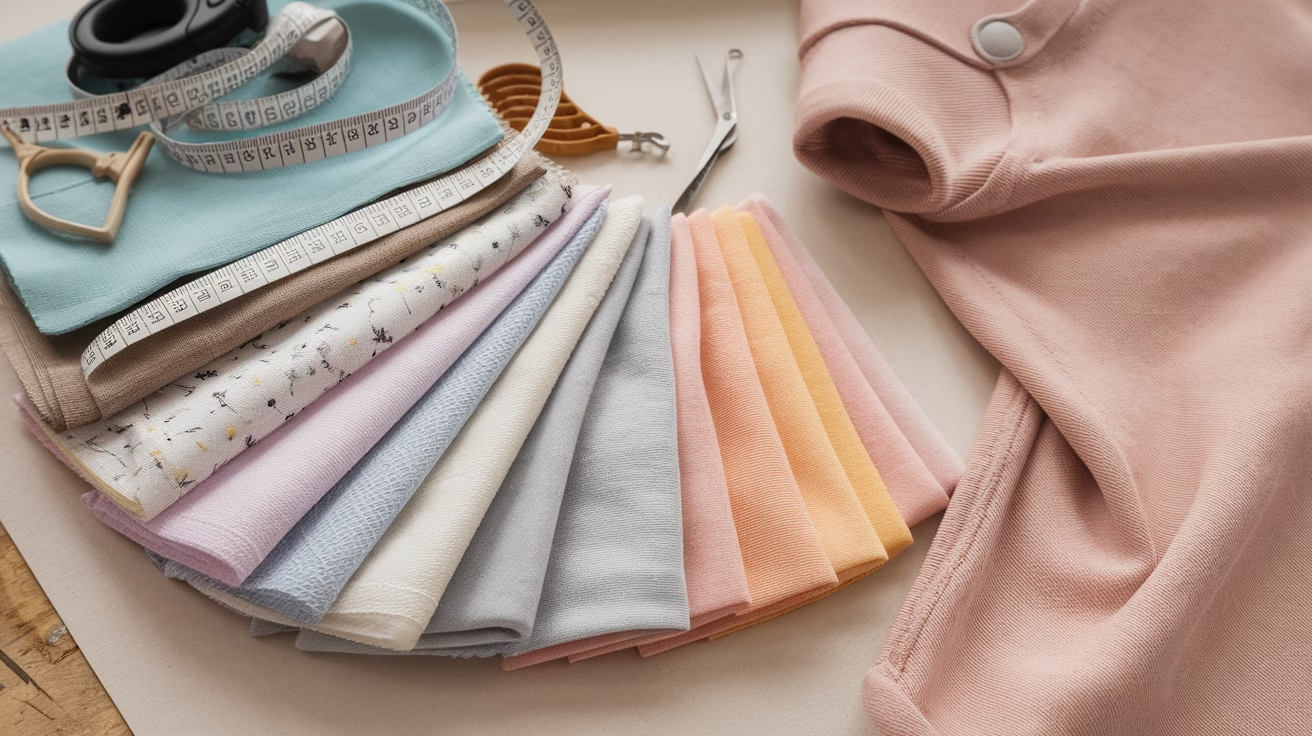
Premium Natural Fabrics Professional Designers Prefer
After understanding the importance of selecting the right fabrics for baby clothes, it’s essential to explore the premium natural materials that professional designers consistently choose. These natural fabrics offer superior quality, comfort, and safety for a baby’s sensitive skin.
Organic Cotton: Hypoallergenic Properties and Chemical-Free Benefits
Organic cotton stands out as a top choice among designers for custom baby clothes due to its hypoallergenic properties. Unlike conventional cotton, organic varieties are grown without harmful pesticides or chemicals, making them ideal for babies with sensitive skin. Professional designers value organic cotton for its:
-
Exceptional softness that remains consistent even after multiple washes
-
Chemical-free production process that eliminates potential irritants
-
Natural breathability that helps regulate body temperature
-
Durability while maintaining gentle contact with delicate skin
Many high-end baby clothing lines prefer unbleached organic cotton drill, which retains its rustic character while offering maximum safety for infants.
Bamboo: Exceptional Softness, Breathability, and Moisture-Wicking Capabilities
Bamboo fabric has gained significant popularity among baby clothing designers for its remarkable qualities:
-
Ultra-soft texture that feels luxurious against a baby’s skin
-
Superior moisture-wicking properties that keep babies dry
-
Excellent breathability that prevents overheating
-
Natural antibacterial properties that reduce odors
Though bamboo fabric can be more expensive than other options, designers choose it for its exceptional comfort and environmental sustainability. Its absorbent nature makes it particularly suitable for garments that come in direct contact with a baby’s skin.
Merino Wool: Temperature Regulation and Self-Cleaning Properties
Merino wool offers unique benefits that make it a premium choice for baby clothing:
-
Outstanding temperature regulation that works in both warm and cold environments
-
Self-cleaning properties that require less frequent washing
-
Natural moisture-wicking capabilities that keep babies comfortable
-
Hypoallergenic qualities, unlike regular wool that may cause itching
Designers particularly value merino wool for its versatility across seasons. Its ability to maintain optimal body temperature makes it suitable for various climates, while its self-cleaning nature adds practicality for busy parents.
Muslin: Lightweight and Breathable for Warm Weather Comfort
Muslin is a designer favorite for summer baby clothing and accessories:
-
Extremely lightweight and airy texture
-
Superior breathability that prevents overheating
-
Versatile fabric that works well for various garment types
-
Soft feel that becomes even softer with washing
This fabric is particularly popular for warm-weather baby clothes, swaddles, and blankets. Its open weave allows maximum airflow while remaining gentle on sensitive skin.
Linen: Natural Moisture-Wicking and Absorbent Qualities
Linen offers exceptional properties that make it ideal for premium baby clothing:
-
Natural moisture-wicking capabilities that keep babies dry
-
High absorbency that helps manage perspiration
-
Hypoallergenic properties suitable for sensitive skin
-
Lightweight feel that’s perfect for warmer seasons
Designers often select linen for shirts, dresses, and summer outfits due to its natural cooling properties. While it requires more care than some other fabrics, its premium feel and performance justify the extra attention.
Now that we’ve explored the premium natural fabrics preferred by professional designers, we’ll next examine synthetic and blended fabrics in baby clothing design. These alternatives offer unique benefits that complement natural materials, providing designers with additional options to create functional and comfortable baby garments.
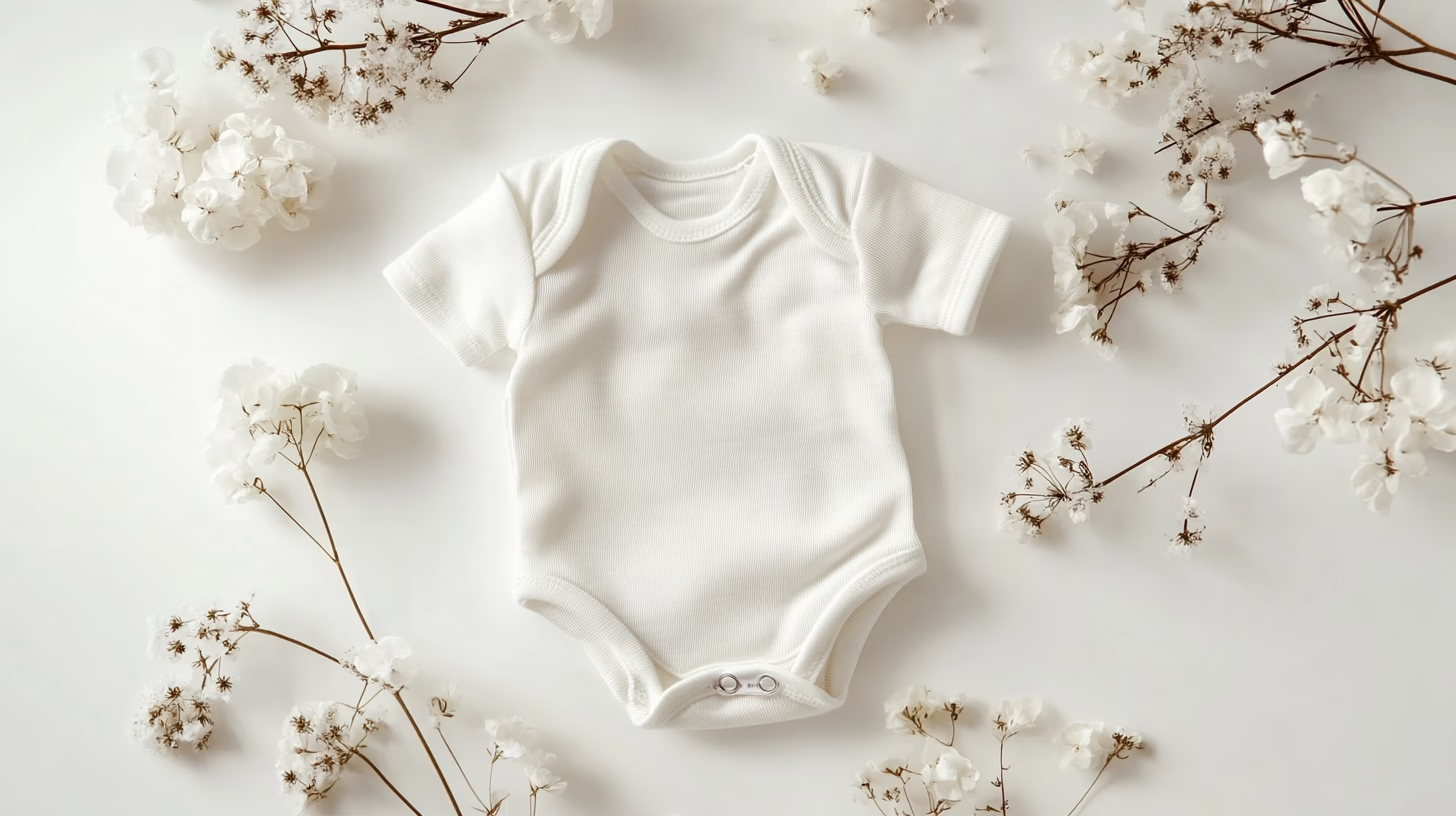
Synthetic and Blended Fabrics in Baby Clothing Design
While premium natural fabrics offer excellent benefits for baby clothes, synthetic and blended options also play an important role in modern baby clothing design. These fabrics can provide specific advantages that complement natural materials, giving designers more versatility when creating functional and comfortable baby garments.
Polyester: Durability and Color Retention Benefits
Polyester is a popular synthetic fabric choice in baby clothing for several practical reasons. It offers exceptional durability and impressive color retention, allowing baby clothes to maintain their vibrant appearance even after multiple washes. Unlike some natural fabrics, polyester resists staining, making it practical for the inevitable messes that come with infants.
However, designers must balance these benefits against polyester’s primary drawback – its limited breathability. While polyester quickly dries and wicks moisture away from the skin, it doesn’t allow for the same level of air circulation as natural fabrics. This can potentially lead to moisture being trapped against a baby’s sensitive skin, which might cause irritation or rashes if worn for extended periods in warm conditions.
Jersey Knit: Stretch and Flexibility for Growing Babies
Jersey knit fabric has become a staple in baby clothing design due to its exceptional stretch and flexibility. This fabric adapts beautifully to a baby’s rapidly changing body, providing comfort and freedom of movement. Jersey knit’s stretchy nature makes it particularly suitable for bodysuits, leggings, and other garments that need to accommodate growth while maintaining shape.
The softness and pliability of jersey knit ensure it won’t irritate a baby’s sensitive skin, while its structure allows for excellent breathability. Professional designers frequently choose jersey knit for everyday baby wear because it combines comfort with practical durability.
Modal: Softness and Resistance to Shrinkage
Modal represents an excellent middle ground between natural and synthetic fabrics. Derived from beech tree pulp, modal offers a luxurious, soft feel that rivals even the finest cotton. Its semi-synthetic nature gives it remarkable resistance to shrinkage, a crucial benefit for baby clothes that undergo frequent washing.
This fabric is particularly suitable for babies with sensitive skin, as it provides a smooth, breathable surface while being highly durable. Modal’s moisture-wicking properties help keep babies dry and comfortable, making it an excellent choice for both everyday wear and sleepwear.
Common Fabric Blends and Their Specific Advantages
Designers often combine different fibers to create blends that maximize the advantages of each material while minimizing drawbacks:
-
Cotton-polyester blends: These combine cotton’s breathability and softness with polyester’s durability and wrinkle resistance. Typically in ratios like 60/40 or 80/20 cotton to polyester, these blends offer greater longevity than pure cotton while maintaining much of its comfort.
-
Cotton-modal blends: This combination enhances the natural softness of cotton while adding modal’s resistance to shrinkage and wrinkling. The result is an ultra-soft, durable fabric ideal for items that come in direct contact with a baby’s skin.
-
Fleece blends: For colder weather, synthetic fleece offers excellent insulation while remaining breathable. Unlike some other synthetic fabrics, fleece allows moisture to evaporate before it can cause skin irritation, making it suitable for outerwear and cold-weather accessories.
When choosing blended fabrics, professional designers carefully consider the ratio of components to ensure the final product maintains breathability while gaining the practical benefits of synthetic materials.
Now that we’ve explored the world of synthetic and blended fabrics, let’s examine how designers adapt their fabric choices based on seasonal considerations, which plays a crucial role in ensuring babies remain comfortable throughout the year.
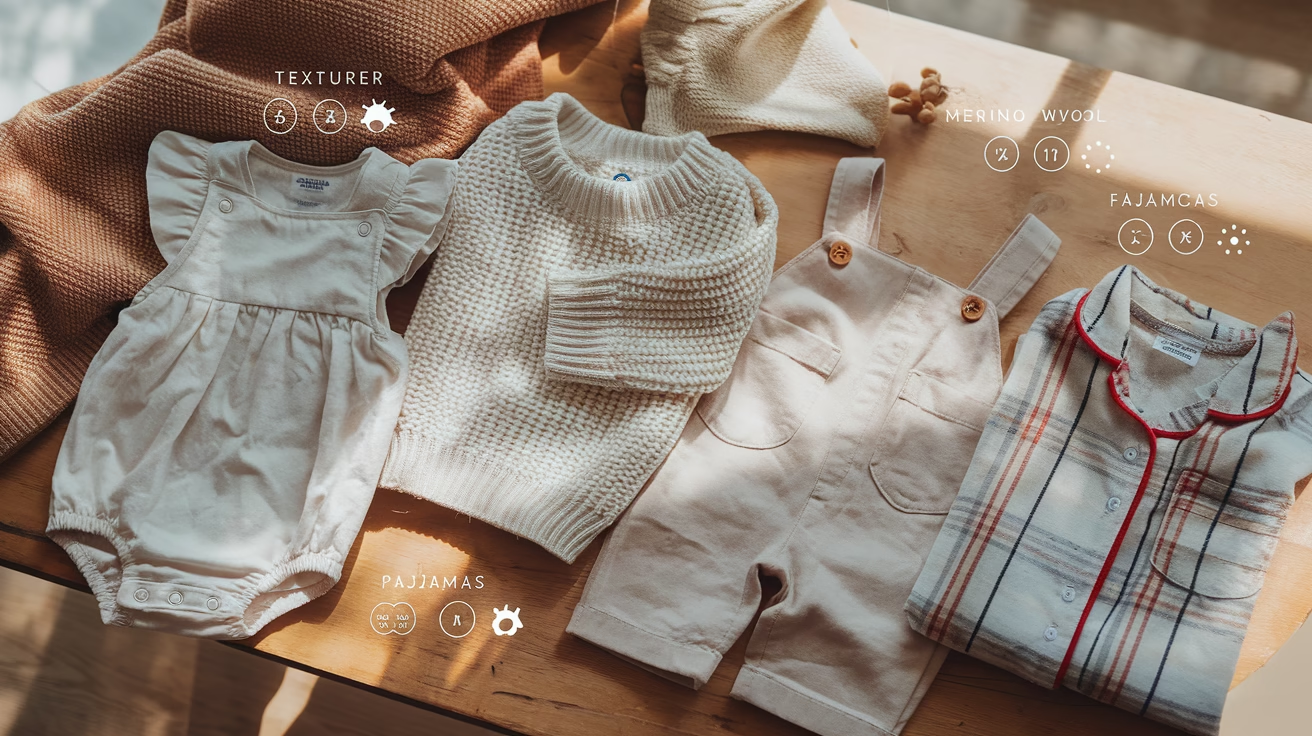
Seasonal Considerations for Baby Fabric Selection
Now that we’ve explored synthetic and blended fabrics for baby clothing design, it’s equally important to understand how fabric selection changes with the seasons. Babies have sensitive thermoregulation systems, making seasonal fabric choices crucial for their comfort and health.
Summer-appropriate fabrics that prevent overheating
During warmer months, lightweight and breathable fabrics are essential to prevent overheating. Lawn cotton stands out as an excellent summer choice due to its lightweight properties and quick-drying capabilities. Muslin is another summer-friendly option, praised for its exceptional breathability, making it perfect for baby essentials in hot weather. Handkerchief linen offers a soft, semi-sheer alternative with a slight texture that provides elegance without adding bulk—ideal for keeping babies cool.
Bamboo cotton blends deserve special mention for summer wear, as they’re lightweight with lower UV penetration rates, providing both comfort and natural sun protection. Pointelle, a unique lightweight cotton fabric with a breathable design, is particularly suitable for summer sleepwear, enhancing air circulation while babies rest.
Winter fabrics that provide warmth without bulk
For colder seasons, merino wool leads the pack as an exceptional winter fabric. Its excellent temperature regulation and moisture-wicking properties make it suitable even for babies with sensitive skin. Unlike traditional wool, merino is soft rather than scratchy, providing warmth without irritation.
Fleece, available in both synthetic and pure cotton forms, offers excellent insulation for winter. The bamboo cotton fleece variant is particularly beneficial as it’s both warm and hypoallergenic. These materials provide necessary warmth without adding uncomfortable bulk that could restrict a baby’s movement.
Cotton terry, initially designed for towels, has found its way into winter baby clothing due to its superior absorbency and soft texture, making it cozy for colder days while remaining gentle on delicate skin.
Layering strategies using different fabric types
Effective layering involves thoughtful fabric combinations that work together to regulate temperature. A common approach is using breathable cotton as a base layer against the skin, followed by insulating materials like fleece or wool for warmth, and finally, a protective outer layer when needed.
Jersey knit cotton makes an excellent base layer due to its stretchability and breathability, accommodating active children’s movements while providing comfort. For middle layers, rib fabrics offer good elasticity and warmth, with eco-friendly options available that maintain sustainability without compromising on comfort.
All-season fabrics that adapt to changing temperatures
Some fabrics perform admirably year-round due to their natural temperature-regulating properties. Organic cotton tops this category, offering breathability in summer and reasonable warmth in winter. Its hypoallergenic nature makes it suitable for continuous use regardless of season.
Bamboo rayon stands out for its thermal-regulating properties, naturally adjusting to the baby’s body temperature. This adaptability makes bamboo-based fabrics ideal for transitional weather or homes with variable indoor temperatures.
Cotton Supima, with its premium, soft texture from rare cotton fibers, maintains its quality through all seasons, providing consistent comfort from summer to winter. Its durability also ensures that garments last through seasonal changes.
With these seasonal fabric considerations in mind, next, we’ll explore how proper fabric care and maintenance can extend the longevity of your baby’s custom clothing, ensuring these carefully selected materials continue to perform at their best through multiple seasons and even multiple children.
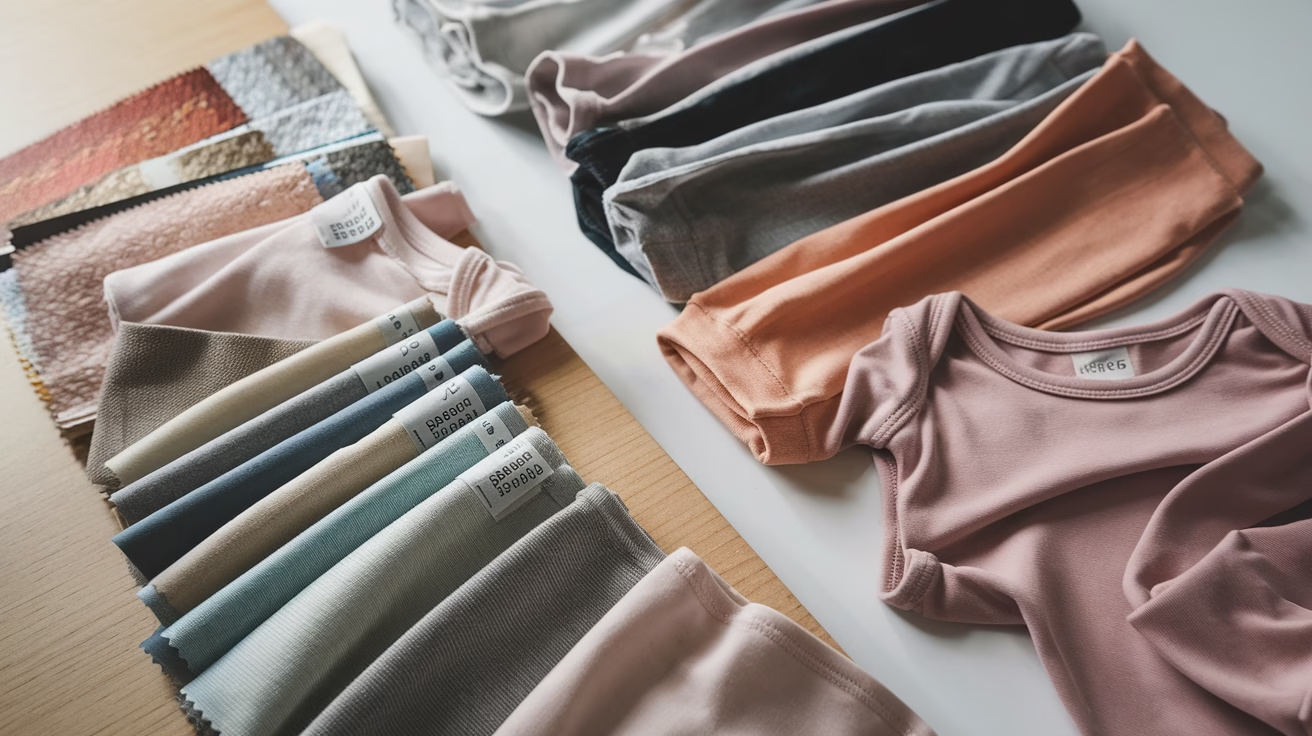
Fabric Care and Maintenance for Longevity
Now that we’ve explored seasonal fabric considerations for baby clothing, it’s equally important to understand how to properly maintain these delicate garments. Proper care not only preserves the appearance of custom baby clothes but also extends their lifespan, making your premium fabric selections a worthwhile investment.
Washing Recommendations for Different Fabric Types
Different baby clothing fabrics require specific washing approaches to maintain their quality:
-
Cotton and Organic Cotton: Wash in gentle cycles with warm or cool water. Organic cotton is particularly delicate and benefits from washing in cool water to preserve its natural properties and eco-friendly benefits.
-
Bamboo Fabric: Use cold or lukewarm water and gentle detergents to preserve bamboo’s softness and antibacterial properties. Avoid hot water which can break down the fiber structure.
-
Wool Items: Hand wash or use wool-specific cycles on your machine. Cold water is best to prevent shrinkage and maintain wool’s natural warmth properties.
-
Synthetic Blends: While more durable, these should still be washed in gentle cycles to maintain their shape and functionality.
Always use hypoallergenic detergents specifically formulated for baby clothes to protect sensitive skin and avoid harsh chemicals that might cause irritation.
Special Care Instructions for Delicate Natural Materials
Natural fabrics used in designer baby clothes require extra attention:
-
Organic Cotton: Turn garments inside out before washing to reduce wear on printed designs and outer surfaces. Avoid fabric softeners which can coat fibers and reduce the natural breathability.
-
Linen: This hypoallergenic option should be washed separately from rougher fabrics to prevent pilling. Air drying is preferred to maintain fiber integrity.
-
Bamboo: Avoid bleach and harsh chemicals which can damage the natural antibacterial properties. Bamboo fabric benefits from being dried in the shade rather than direct sunlight.
-
Wool: Store clean wool items with cedar blocks rather than mothballs to avoid chemical exposure. Wool requires proper drying techniques—lay flat rather than hanging to prevent stretching.
Stain Removal Techniques Safe for Baby Clothes
Baby garments frequently encounter stains, but harsh chemicals aren’t necessary for effective cleaning:
-
Immediate Action: Address stains promptly by rinsing with cold water from the backside of the fabric to push the stain out rather than in.
-
Natural Solutions: For organic and premium fabrics, use natural stain removers like diluted lemon juice, baking soda paste, or white vinegar solutions rather than commercial stain removers.
-
Sun Bleaching: Harness the natural bleaching power of sunlight for organic fabrics—after washing, place wet garments in direct sunlight to naturally fade stains without chemicals.
-
Gentle Techniques: For persistent stains, use a soft-bristled brush rather than harsh scrubbing, which can damage delicate fibers in premium materials.
Extending Garment Life Through Proper Fabric Care
To maximize the longevity of custom baby clothes:
-
Proper Storage: Organize baby clothes in labeled bins by size and season. This prevents unnecessary handling and maintains fabric quality when not in use.
-
Regular Inspection: Check for weak spots or loose threads and address them early before they become larger issues, especially in high-wear areas.
-
Appropriate Drying: Air drying is preferable for most natural fabrics used in designer baby clothes. If using a dryer, select low heat settings and remove promptly to prevent wrinkles and unnecessary wear.
-
Rotation System: Implement a clothing rotation system to distribute wear evenly across garments, particularly for everyday items made from premium materials.
By following these specific care instructions for your baby’s custom clothing, you’ll protect your investment in high-quality, designer pieces while ensuring they remain gentle on your baby’s sensitive skin throughout their use.
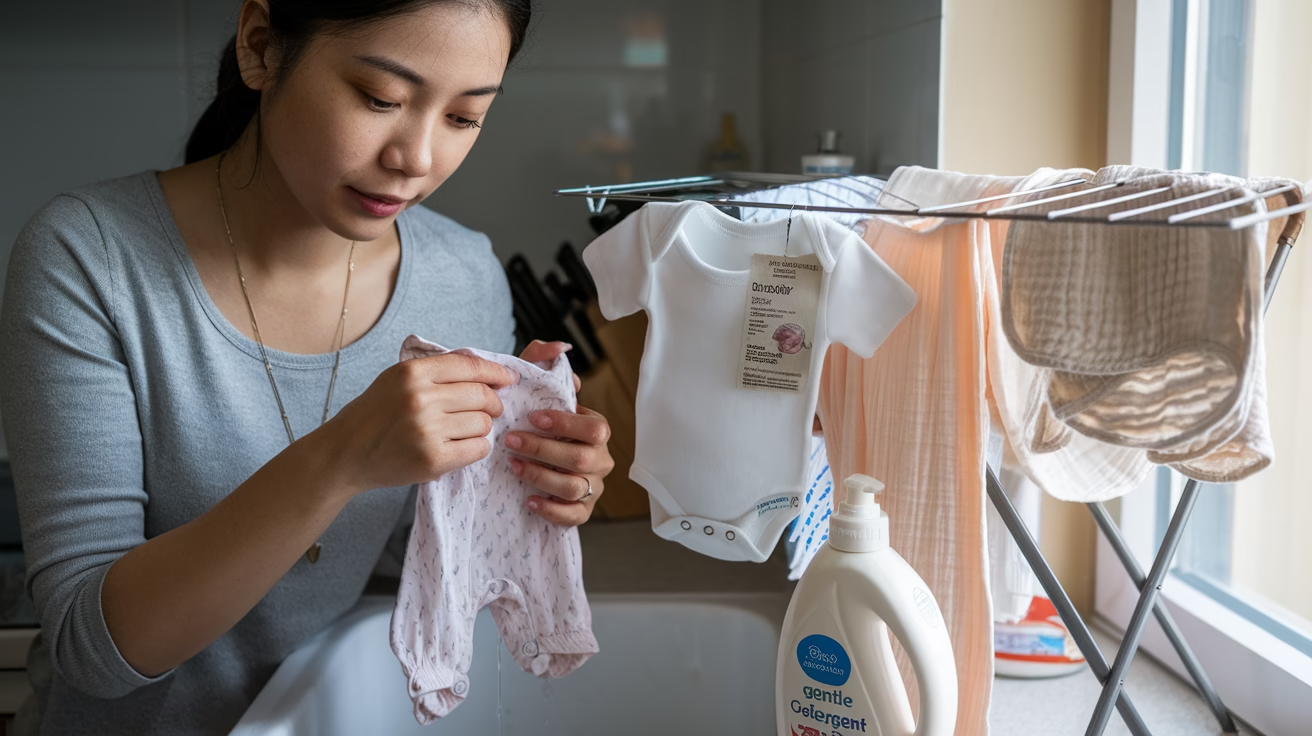
Conclusion
The Heart of Baby Fashion: Fabric First
Selecting the right fabrics for baby clothes is much more than a design choice—it’s a commitment to your little one’s comfort, safety, and well-being. Throughout this guide, we’ve explored how professional designers prioritize natural fabrics like organic cotton, bamboo, and merino wool for their exceptional softness, breathability, and gentle touch on delicate skin. We’ve also examined how certain synthetic blends can offer practical benefits when chosen wisely, and how seasonal considerations should influence your fabric selections to keep babies comfortable year-round.
As you embark on your journey of creating or selecting custom baby clothes, remember that proper care and maintenance are essential for preserving the quality and extending the life of these special garments. Whether you’re a professional designer, a crafty parent, or simply a caregiver looking for the best options, prioritizing premium fabrics is the foundation of creating baby clothes that are not just adorable but truly beneficial for infant development and comfort. Your fabric choices today create the soft, supportive environment your little one deserves as they grow and explore their world.
Petelulu is Your Best Partner for Starting Your Kids’ Clothing Line
If you’re looking for a reliable clothing manufacturer for your children’s clothing line, Appareify will be your top choice. Here is why we can relieve stress for your kids’ clothing business:
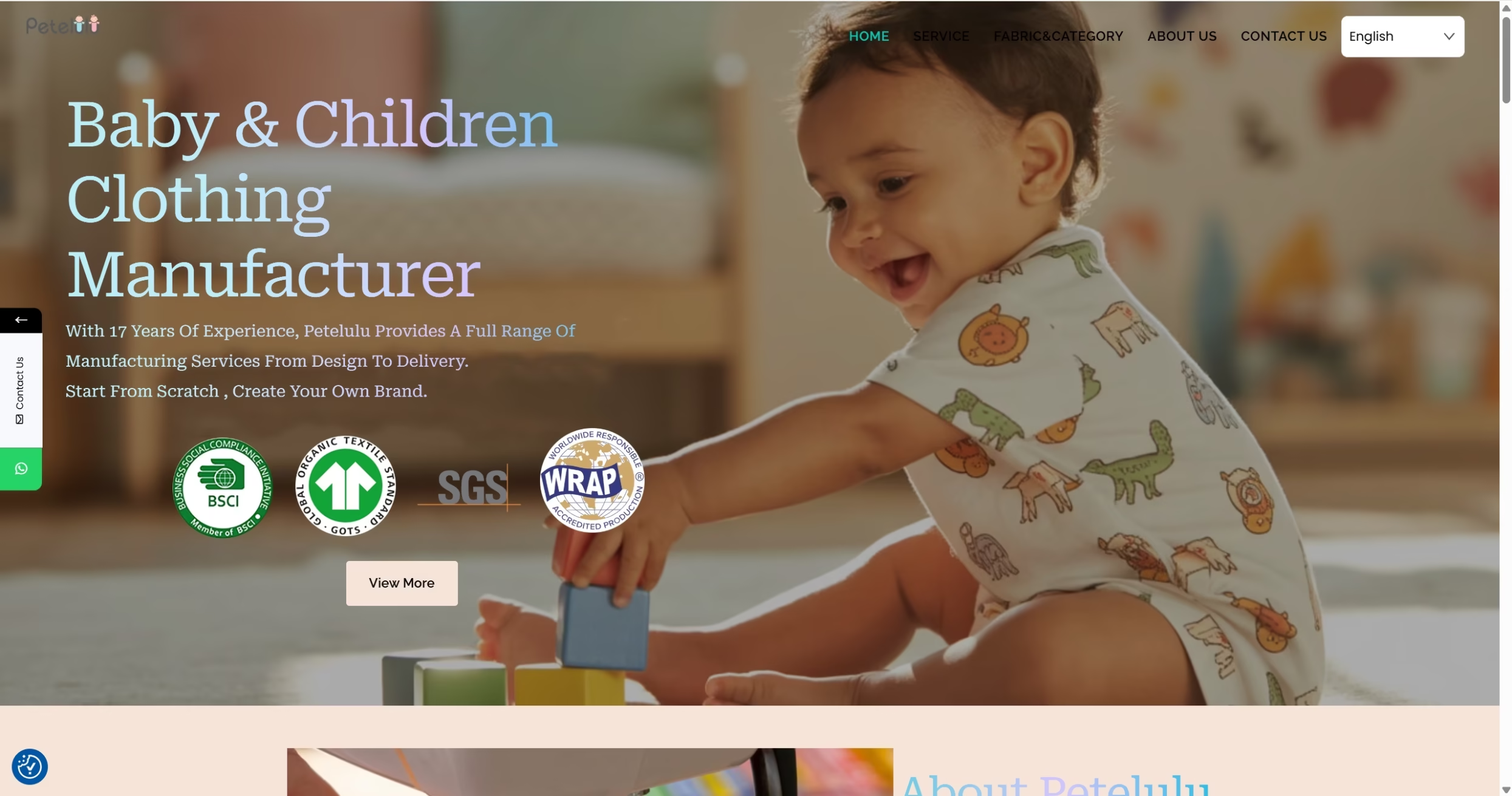
Custom Children’s Clothing Manufacturer
Appareify is a leading clothing manufacturer that has assisted many businesses with their own range of bespoke clothing. We can create children’s clothing tailored for your style and material needs
Experienced Production & Team
Partner with Appareify and benefit from our years of clothing manufacturing expertise. Our professional design and production experts can easily turn your business ideas into reality.
Sustainable Commitment
We use biodegradable materials and fabrics to turn your ideas into reality sustainably. You’ll get children’s clothing that is friendly to the environment.